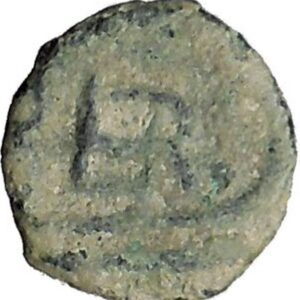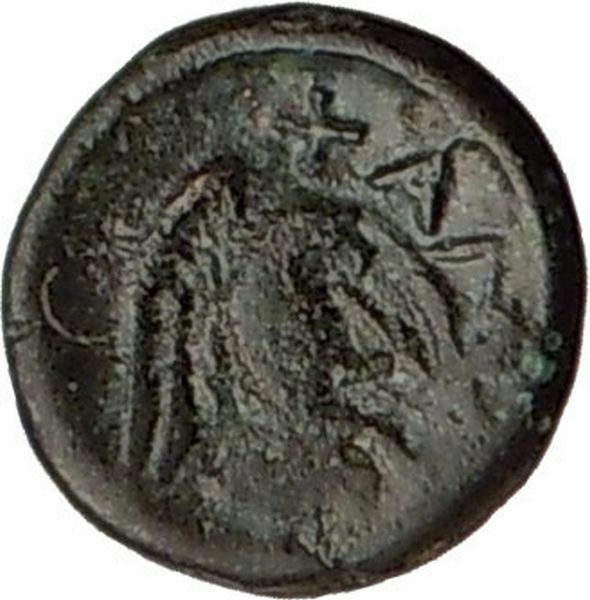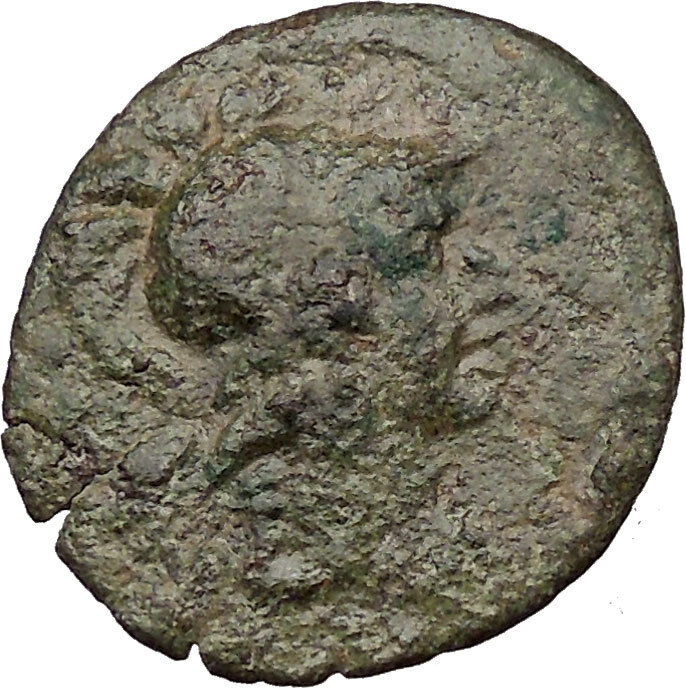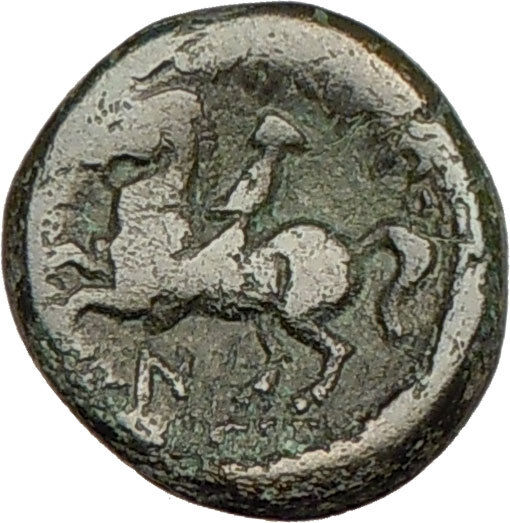|
– King: 323-281 B.C. –
Bronze 14mm (2.75 grams) Struck in the Kingdom of Thrace circa 297-281 B.C.
Reference: Sear 6822; Muller, pl. II,14; Forrer/Weber 2735
Head of young Hercules right, clad in lion’s skin.
BAΣΙ / ΛΥΣI within corn-wreath.
One of the most remarkable of the ‘Successors’ of Alexander, Lysimachos was of Thessalian stock and was a bodyguard of the great Macedonian King. In the confused period following Alexander’s death he obtained the government of Thrace, and in 309 B.C. founded his capital city of Lysimacheia where many of his coins were struck. In 305 B.C. he took the title of King, and four years later extended his rule over much of Asia Minor following the defeat of Antigonos the One-eyed at Ipos. His later years were marred by domestic tragedy and his harsh rule made him unpopular with his subjects. In 281 B.C. Lysimachos, now aged 80, was attacked by Seleukos of Syria who was only two years his junior. Lysimachos died fighting at the battle of Korupedion and his kingdom disappeared with him. But his memory lived on and generations later a number of mints in the Black Sea area restored his coin types for their autonomous issues.
You are bidding on the exact item pictured, provided with a Certificate of Authenticity and Lifetime Guarantee of Authenticity.
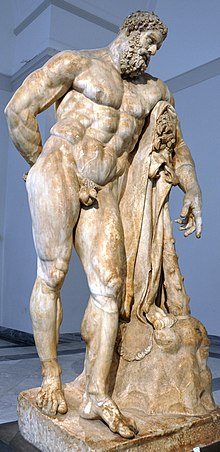
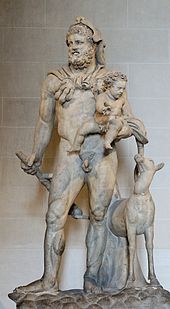 Heracles, born Alcaeus (Alkaios) or Alcides, was a divine hero in Greek mythology, the son of Zeus and Alcmene, foster son of Amphitryon and great-grandson and half-brother (as they are both sired by the god Zeus) of Perseus. He was the greatest of the Greek heroes, a paragon of masculinity, the ancestor of royal clans who claimed to be Heracleidae and a champion of the Olympian order against chthonic monsters. In Rome and the modern West, he is known as Hercules, with whom the later Roman emperors, in particular Commodus and Maximian, often identified themselves. The Romans adopted the Greek version of his life and works essentially unchanged, but added anecdotal detail of their own, some of it linking the hero with the geography of the Central Mediterranean. Details of his cult were adapted to Rome as well.
Heracles, born Alcaeus (Alkaios) or Alcides, was a divine hero in Greek mythology, the son of Zeus and Alcmene, foster son of Amphitryon and great-grandson and half-brother (as they are both sired by the god Zeus) of Perseus. He was the greatest of the Greek heroes, a paragon of masculinity, the ancestor of royal clans who claimed to be Heracleidae and a champion of the Olympian order against chthonic monsters. In Rome and the modern West, he is known as Hercules, with whom the later Roman emperors, in particular Commodus and Maximian, often identified themselves. The Romans adopted the Greek version of his life and works essentially unchanged, but added anecdotal detail of their own, some of it linking the hero with the geography of the Central Mediterranean. Details of his cult were adapted to Rome as well.
Extraordinary strength, courage, ingenuity, and sexual prowess with both males and females were among the characteristics commonly attributed to him. Heracles used his wits on several occasions when his strength did not suffice, such as when laboring for the king Augeas of Elis, wrestling the giant Antaeus, or tricking Atlas into taking the sky back onto his shoulders. Together with Hermes he was the patron and protector of gymnasia and palaestrae. His iconographic attributes are the lion skin and the club. These qualities did not prevent him from being regarded as a playful figure who used games to relax from his labors and played a great deal with children. By conquering dangerous archaic forces he is said to have “made the world safe for mankind” and to be its benefactor. Heracles was an extremely passionate and emotional individual, capable of doing both great deeds for his friends (such as wrestling with Thanatos on behalf of Prince Admetus, who had regaled Heracles with his hospitality, or restoring his friend Tyndareus to the throne of Sparta after he was overthrown) and being a terrible enemy who would wreak horrible vengeance on those who crossed him, as Augeas, Neleus and Laomedon all found out to their cost.
,_copia_augustea_(23_ac-14_dc)_da_orig._del_II_sec_ac._6141.JPG/220px-Lisimaco_(c.d.),_copia_augustea_(23_ac-14_dc)_da_orig._del_II_sec_ac._6141.JPG)
Early life and career
Lysimachus was born in 362/361 BC, to a family of Thessalian Greek stock. He was the second son of Agathocles and his wife; there is some indication in the historical sources that this wife was perhaps named Arsinoe, and that Lysimachus’ paternal grandfather may have been called Alcimachus. His father was a nobleman of high rank who was an intimate friend of Philip II of Macedon, who shared in Philip II’s councils and became a favorite in the Argead court. Lysimachus and his brothers grew up with the status of Macedonians; all these brothers enjoyed with Lysimachus prominent positions in Alexander’s circle and, like him, were educated at the Macedonian court in Pella.
He was probably appointed Somatophylax during the reign of Philip II. During Alexander’s Persian campaigns, he was one of his immediate bodyguards. In 324 BC, in Susa, he was crowned in recognition for his actions in India. After Alexander’s death in 323 BC, he was appointed to the government of Thrace as strategos.
Diadochi
In 315 BC, he joined Cassander, Ptolemy I Soter and Seleucus I Nicator against Antigonus I Monophthalmus, who, however, diverted his attention by stirring up Thracian and Scythian tribes against him. In 309 BC, he founded Lysimachia in a commanding situation on the neck connecting the Chersonese with the mainland. He followed the example of Antigonus I in taking the title of king.
In 306/305 BC, he assumed the title of “King”, which he held until his death at Corupedium in 282/1 BC.
In 302 BC, when the second affiance between Cassander, Ptolemy I and Seleucus I was made, Lysimachus, reinforced by troops from Cassander, entered Asia Minor, where he met with little resistance. On the approach of Antigonus I he retired into winter quarters near Heraclea, marrying its widowed queen Amastris, a Persian princess. Seleucus I joined him in 301 BC, and at the battle of Ipsus Antigonus I was defeated and slain. His dominions were divided among the victors. Lysimachus’ share was Lydia, Ionia, Phrygia and the north coast of Asia Minor.
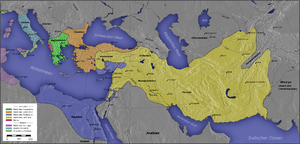
Other diadochi
Other
Feeling that Seleucus I was becoming dangerously great, Lysimachus now allied himself with Ptolemy I, marrying his daughter Arsinoe II of Egypt. Amastris, who had divorced herself from him, returned to Heraclea. When Antigonus I’s son Demetrius I renewed hostilities (297 BC), during his absence in Greece, Lysimachus seized his towns in Asia Minor, but in 294 BC concluded a peace whereby Demetrius I was recognized as ruler of Macedonia. He tried to carry his power beyond the Danube, but was defeated and taken prisoner by the Getae king Dromichaetes (Dromihete), who, however, set him free on amicable terms. Demetrius I subsequently threatened Thrace, but had to retire due to a sudden uprising in Boeotia, and an attack from the King Pyrrhus of Epirus.
In 288 BC, Lysimachus and Pyrrhus in turn invaded Macedonia, and drove Demetrius I out of the country. Lysimachus left Pyrrhus in possession of Macedonia with the title of king for around seven months before Lysimachus invaded. For a short while the two ruled jointly but in 285 BC Lysimachus expelled Pyrrhus, seizing complete control for himself.
Later years
Domestic troubles embittered the last years of Lysimachus’ life. Amastris had been murdered by her two sons; Lysimachus treacherously put them to death. On his return, Arsinoe II asked the gift of Heraclea, and he granted her request, though he had promised to free the city. In 284 BC Arsinoe II, desirous of gaining the succession for her sons in preference to Lysimachus’ first child, Agathocles, intrigued against him with the help of Arsinoe II’s paternal half-brother Ptolemy Keraunos; they accused him of conspiring with Seleucus I to seize the throne, and Agathocles was put to death.
This atrocious deed of Lysimachus aroused great indignation. Many of the cities of Asia Minor revolted, and his most trusted friends deserted him. The widow of Agathocles and their children fled to Seleucus I, who at once invaded the territory of Lysimachus in Asia. In 281 BC, Lysimachus crossed the Hellespont into Lydia and at the decisive Battle of Corupedium was killed. After some days his body was found on the field, protected from birds of prey by his faithful dog. Lysimachus’ body was given over to another son Alexander, by whom it was interred at Lysimachia.
Marriages and children
Lysimachus was married three times and his wives were:
- First marriage: Nicaea a Greek Macedonian noblewoman and daughter of the powerful Regent Antipater. Lysimachus and Nicaea married in c. 321 BC. Nicaea bore Lysimachus three children:
- Son, Agathocles
- Daughter, Eurydice
- Daughter, Arsinoe I
Nicaea most probably died by 302 BC.
- Second marriage: Persian Princess Amastris. Lysimachus married her in 302 BC. Amastris and Lysimachus’ union was brief, as he ended their marriage and divorced her in 300/299 BC. Amastris had two sons from a previous marriage. During their brief marriage, Amastris may have borne Lysimachus a child, perhaps a daughter who may have been the first wife of Ptolemy Keraunos.
- Third marriage: Ptolemaic Greek Princess Arsinoe II. Arsinoe II married Lysimachus in 300/299 BC and remained with him until his death in 281 BC. Arsinoe II bore Lysimachus three sons:
- Ptolemy I Epigone
- Lysimachus
- Philip
From an Odrysian concubine he had a son borne to him called Alexander.
See also
- Belevi Mausoleum
Frequently Asked Questions
Who am I dealing with?
How long until my order is shipped?
How will I know when the order was shipped?
What is a certificate of authenticity and what guarantees do you give that the item is authentic?
Is there a money back guarantee?
Is there a number I can call you with questions about my order?
When should I leave feedback?
How and where do I learn more about collecting ancient coins?
|







